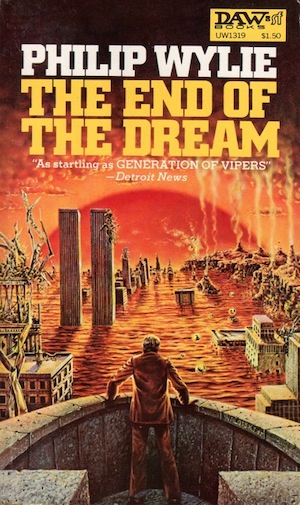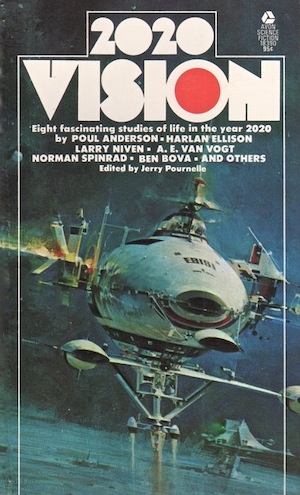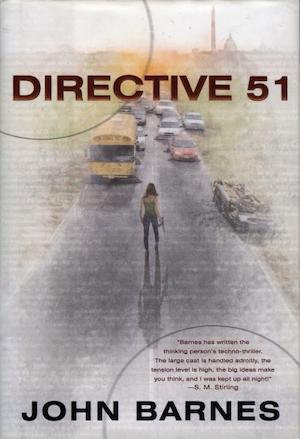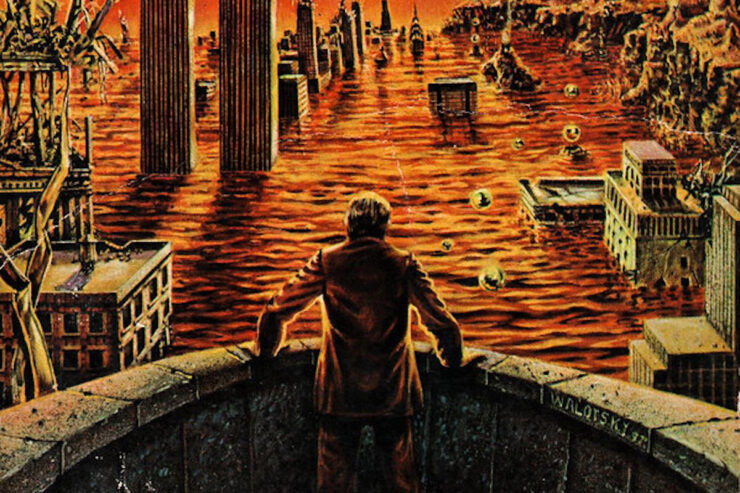The 2020s were once reassuringly in the distant future, and a popular setting for science fiction; now we find ourselves living in that decade. How prescient were those SF authors of the past? Are their predicted settings anything like current conditions? And how much amusement may modern readers derive from visions of yesterday’s tomorrow? Let’s find out!
The End of the Dream by Philip Wylie (1972)

The optimism of the 1970s proves unfounded. The decades that follow are a series of escalating cataclysms caused by humanity’s ecological hubris. Great cities burn. Rivers boil. Pollution poisons the air. Billions die. The calamities spare no one.
However, calamity brings reform. By June 6, 2023, the few remaining humans have seen the error of their ways. An ecologically prudent world government oversees recovery. Too bad for the survivors that their efforts are just a smidge too belated.
This is basically a stupider, much louder version of Brunner’s The Sheep Look Up (or given the publication dates, Brunner’s novel is the much-improved version of The End of the Dream). I am a little surprised that this book was never the basis for a disaster film, given that other Wylie works made it to the silver screen.
2020 Vision edited by Jerry Pournelle (1974)

There were two desiderata for stories selected for this collection. Stories had to be set in the year 20201. The settings had to be plausible; there would be no tales featuring super-science or pseudoscience unless the author thought those were plausible. Pournelle took the further step of inviting readers to critique the predictions at the 2020 Worldcon, an unusual invitation that for various reasons proved impractical2.
So, how does this collection stand up? The stories are a mixed bag but most reward reading. Some imagine a US that has been much reduced, whether conquered by the rascally Soviets or dominated by Japanese commercial prowess. Others imagine a US that is still prosperous. Most of the authors thought crewed space travel would be more developed than it is.
For the most part, the stories reflect the anxieties of 1970 more than they do the anxieties of 20203. There are two partial exceptions. David McDaniel’s Prognosis: Terminal focuses on the impact of technological change upon artists; the details are not our details, but the feel is familiar. Dian Girard’s “Eat, Drink, and Be Merry” imagines a world in which women are denied bodily autonomy to the extent that they aren’t even allowed to select their own meals. No doubt she was inspired by the status of women in the 1970s. Nevertheless, it would be easy to find modern analogs to her protagonist’s situation.
Rule 34 by Charles Stross (2011)

In Stross’ setting, the inexorable march of Moore’s Law has led to impressively capable robots, home fabricators, and powerful software that is insufficiently documented. There are new nations, many of them corruptible. This could be a golden age for criminal innovation… or so the criminal organization known as the Organization thinks.
Across Europe, criminals suffer fatal (in some cases NSFW) mishaps. Each might be the product of unlikely, but possible, chance. Taken together, they suggest that some unseen architect is at work, methodically eliminating Europe’s criminals. Will Inspector Kavanaugh catch the mastermind? Will career criminals Anwar and the Toymaker survive the mastermind’s attention?
Aside from computers and robotics not being quite as far along as envisioned, the big difference between Stross’ version of the 2020s and ours is this: Stross assumed global scale corruption and criminality would require competence, whereas it turns out that’s an optional extra. Sufficiently determined, well-placed nincompoops can get surprising far.
Parable of the Sower by Octavia Butler (1993)

The United States of America of the 2020s can maintain lunar bases and dispatch expeditions to Mars. What the US cannot do, or chooses not to do because the short-term consequences would be inconvenient, is to address climate change or the slow but inexorable collapse of civilization that results. Absent effective federal or state response, individual Americans are forced to cope with an increasingly dysfunctional society as best they can.
Lauren Olamina’s family is comparatively lucky. Their enclave has thus far been secure. Lauren’s father still has his job. Safety is an illusion, alas. Lauren’s relatives are murdered and her home is looted and burned. Lauren herself is forced to search for refuge in a world where the only guarantee is that things will get worse.
I cannot help but notice that this series is the only one of the five listed here that I see frequently cited on social media, often with particular attention directed to particular passages. Of what possible relevance to our era could a dystopia driven by greed, fear, and foolishness have? Sadly, I lack the space to address this.
Directive 51 by John Barnes (2010)

In this setting, the 2024 US presidential election is looming. The US and the world in general appear to face purely conventional threats, such as terrorism. In fact, computer tech has passed an inflection point that allows a few determined, networked amateurs to wreak apocalyptic havoc. On their own, none of Daybreak’s members are significant threats. Together, they can—and do—kneecap civilization.
Gigaton explosions bloom across the planet. America’s president and everyone in the line of succession are dead. What survives of the nation is riven by a near civil war between factions led by two surviving senior functionaries, Graham Weisbrod and Cameron Nguyen-Peters4.
Barnes offers a much more placid 2010 to 2024 than we actually got, albeit with a significant bill to be paid at the end. The notion that the loser of a presidential election might simply refuse to acknowledge his loss seems more prescient now than it did in 2010. At least there’s no sign of deranged third parties rendering the electoral dispute moot through the use of gigaton nukes—at least so far. 2024 has been a year of surprises…
These are only a few of the 2020s that SF authors have imagined. There are many I did not mention. In retrospect, it’s a little odd there were so few that offered optimistic views of our current era. Feel free share your favorites in the comments below.
- Pournelle’s theme (2020) for his collection was a half-century in the future when he commissioned the stories. The theme was only forty-six years away when the book finally appeared. Blame publishing delays.
- If there had been a panel about Pournelle’s collection at the 2020 Worldcon, that would have been fun. Too bad no one took this notion and ran with it. Or at least, they did not so far as I know.
- More re: Pournelle’s book: readers may want to skip Poul Anderson’s story “The Pugilist” and they most definitely want to avoid even a description of the Van Vogt.
- It is pretty clear that the US succession rules were never play-tested by disruptive, hostile rules-lawyers. In the US’s defense, I can think of an analogous order of operations issue in Canada’s Westminster-style settler governments. So far as I know the issue has never been properly clarified in the Canadian context: what happens when the PM and Governor General dismiss each other simultaneously? Aside from hilarity, I mean.











Though Barnes never outright says it, there are enough hints in the Daybreak trilogy to surmise that the events are, if not orchestrated by, put in motion by entities who would rather Earth did not have a technological civilization. Daybreak itself is a meme, much like those in his Kaleidoscope Century novels, and something put the self-replicating weapons on the moon…
It’s a pity publisher issues left us with a truncated book 3 and the rest of the series on the drawing board. It would have made an interesting alternative to SM Stirling’s Emberverse and Sean McMullen’s Greatwinter.
It has been pointed out to me that I overlooked Disch’s 334.
A lot of the original cyberpunk authors set their works in the 2020s. In Hardwired there are orbital settlements and the US has high-speed rail (and also recently lost a war in the homeland), none of which are close. In Islands in the Net there are democratically run corporations, effective gun control in the US, and wars are only occurring in Africa.
I remember when cyberpunk didn’t sound optimistic…
Back in 1994, I took the basic setting of my recently ended college Champions mega-campaign, stripped out all the IP I didn’t own, and started writing superhero technothrillers set in the post-almost-apocalyptic year of 2022. I’m still writing in that setting (it’s only made it to 2027), but one thing I have to do pretty often is check word origins. “Was that term around before the near-apocalypse of 1998? If not, is it eve plausible that it could have been coined?” There are no “smartphones,” they’re still cellphones, and I had to develop alternate slang for them, for instance. Sometimes the future catches up to your past.
S.M Stirling’s Emberverse does not seem as botjhered by this issue, especially with regard to music. The protagonist of one book sings S.J. Tucker’s To My Valentine, which was written in 2010, long after the apocalypse of 1998. There are other examples which I can’t quite bring to mind.
Who the heck built “gigaton” nuclear weapons to begin with?
To begin with, the Soviet Union, early in the Cold War, started a project to develop a gigaton weapon. They managed to produce a 100 megaton weapon, the Tsar Bomba, but canceled the project because it was too heavy to be usable.
As JDN points out, the weapon would only be useful as a Dr. Strangelove doomsday device.
Misguided extremists inflamed by weaponized semiotics.
Rather annoyingly, Nuke Maps model can’t handle yields that high. Generally speaking, for all but one application, GT nukes are kind of pointless because so much of the energy is wasted. The exception is doomsday devices, where a super-duper nuke wrapped in something unpleasant like cobalt is the very thing. At least the GT devices in D51 aren’t designed for maximum fallout.
(4) The current succession rules were devised as an insurance policy, against the case of the president and vice president both dying during a presidential term, and the main change was to add a lot more steps to the succession–before that, it was VP, Speaker of the House, and then the otherwise-unimportant President Pro Tem of Senate, and the idea that if necessary, the Speaker becomes president, and the House immediately meets to elect a new speaker.
They may not have envisioned the VP and president resigning due to separate scandals. I’m pretty sure they didn’t expect a House of Representatives taking weeks to select a new speaker.
One small consequence of the current rules is that president and everyone in the line of succesion are never in the same city at the same time. This means some low-ranking member of the presidential cabinet who is legally qualified for the presidency is chosen to be out of town during the State of the Union address.
There have also been untested arguments that detouring the succession through the legislative branch at all before returning to the cabinet may not be constitutional. Those can be expected to at least be raised the first time the Speaker (or President Pro Tem of the Senate if it comes to it) is of a different party from the late or former President and Vice President.
Since that’s an amendment to the Constitution–oh, wait, our Court has declared the 13th amendment no longer applies to women or girls, never mind,
Do Androids Dream of Electric Sheep? (and Blade Runner) is set in 2019.
Actually, Androids… was set in 1992. The time period was changed in post Blade Runner editions of the novel
This is somewhat off the mark, but I remember seeing, at an impressionable age, a TV show called 2017 where everyone lived underground due to air pollution. Google informs me that this was a 1971 episode of “The Name of the Game”, written by Philip Wylie and directed by Steven Spielberg.
My first unsold spec novel, which I wrote in 1992-3, took place from 2020-25 and was about the first feature film shot in space, accompanying the first permanent colony expedition to Mars. I called it On Location, inspired by the gag credit in the Star Wars spoof film Hardware Wars, “Filmed on location in space.” Heck, I think the whole novel was inspired by that gag (as well as by Werner Herzog’s insistence on shooting Fitzcarraldo‘s arduous steamship journey for real instead of with miniature effects).
I was overoptimistic about the Mars mission timetable, but I was kind of in the ballpark in positing an increase in private investment in spaceflight in the 2020s, as well as filmmakers embracing a renaissance in practical effects after decades of overreliance on CGI. I posited the election of the first Black US president in 2016, re-elected in 2020. Nuclear fusion was also perfected in 2016. The environment was improving, but people in the First World had grown complacent about how much work still had to be done (e.g. they had an “anti-ultraviolet vaccine” so they didn’t care that the ozone layer was still deteriorating). At least I was right about electric cars being common.
I actually wrote the entire screenplay for the movie first, so that I could construct the novel’s plot around its production needs and a plausible shooting schedule. Some years later, I went back and reread them both, and though the novel wasn’t too bad for a first attempt, the screenplay was pretty dull.